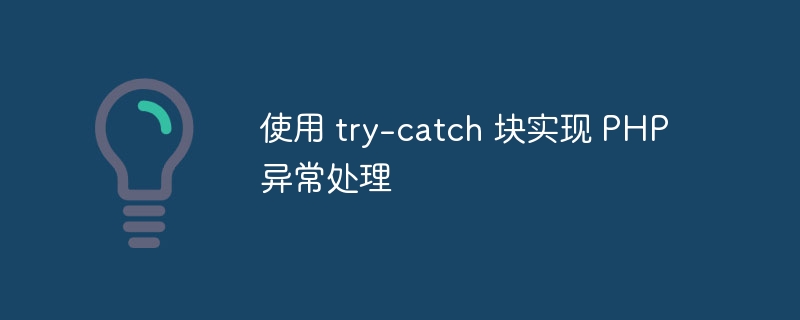

Use try-catch block to implement PHP exception handling
In PHP development, exception handling is a very important technology, which allows us to have better control and handling error conditions in your code. In PHP, we can use try-catch blocks to implement exception handling, making the code more robust and reliable.
Let’s explain in detail how to use try-catch blocks for exception handling in PHP.
First of all, we need to understand what an exception is. In PHP, an exception is an error or unusual condition that occurs during program execution. Generally speaking, we will use try-catch blocks in the code to catch these exceptions and handle them accordingly.
The basic syntax of a try-catch block is as follows:
try {
// 可能会抛出异常的代码块
} catch (Exception $e) {
// 捕捉到异常后的处理代码
}
In this example, we can see that the try-catch block consists of two parts, namely the try code block and the catch code block.
The try code block is the code block where we need to handle exceptions. We can write code here that may throw exceptions. When an exception occurs in the try code block, the exception will be caught by the catch code block and handled accordingly.
catch code block is where exception handling occurs, where we can write handling code. Generally speaking, we will choose different handling methods according to the type of exception. Normally, we will use the exception's getMessage() method to obtain the details of the exception, and handle it accordingly according to the exception situation.
The following is a specific code example showing how to use try-catch blocks for exception handling:
try {
// 可能会抛出异常的代码块
$file = fopen("filename.txt", "r");
if ($file === false) {
throw new Exception("文件打开失败。");
}
// 其他的代码逻辑} catch (Exception $e) {
// 捕捉到异常后的处理代码 echo "发生了异常:" . $e->getMessage();
}
In this example, we first try to open a file "filename.txt". If the file fails to open, we will manually throw an Exception and set the exception information to "File opening failed." Next, in the catch code block, we will catch this exception and get the details of the exception through the getMessage() method.
Through this example, we can see that using try-catch blocks allows us to better control and handle exceptions in the program, thereby improving the robustness and reliability of the code.
In addition to the above basic usage, PHP also supports some advanced exception handling technologies, such as using multiple catch code blocks to handle different types of exceptions, using the throw keyword to actively throw exceptions, etc. These technologies allow us to have more fine-grained control and handling of exceptions.
To sum up, exception handling is a very important technology in PHP development, which can help us better control and handle error situations in the code. By using try-catch blocks, we can catch and handle exceptions, thereby improving the robustness and reliability of our code. I hope this article will help everyone understand and master PHP exception handling technology.
The above is the detailed content of Implementing PHP exception handling using try-catch blocks. For more information, please follow other related articles on the PHP Chinese website!